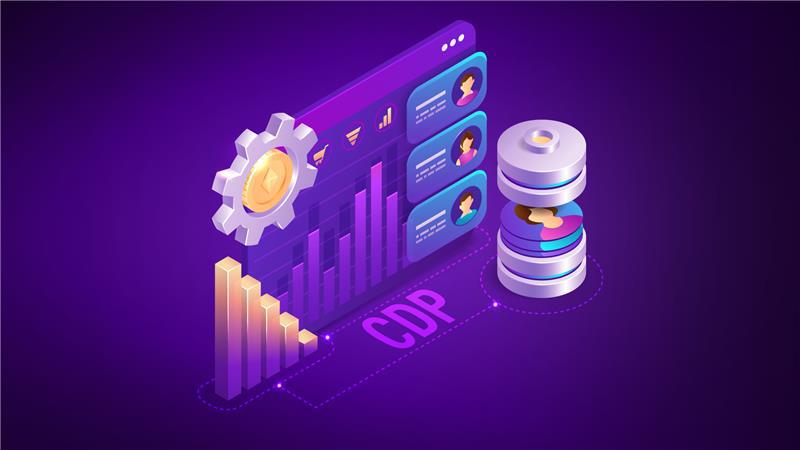What is a Customer Data Platform (CDP)? CDP Explained

Customer Data Platform (CDP) has become an important way to deliver analytics and insights to enhance customer experiences and monetization. In Salesforce’s latest “State of Marketing” report, 78% of high performers said they use a CDP, versus 58% of underperformers. In this blog, we’ll explain what a CDP is, how is it different from a data lake and an enterprise data warehouse, and what its different features and components are. We’ll also outline how you can get started with this journey, and how you can minimize your deployment times to maximize your ROI.
What is a Customer Data Platform?
A Customer Data Platform (CDP) is a software that enables you to collect customer data from a variety of sources, such as websites, mobile apps, social media, and customer support and commerce interactions. It then creates a complete profile of each customer. This profile includes details such as demographics, behavior, purchase history, and preferences. This data is then used to generate insights that then lead to personalized marketing campaigns, better customer experiences, and optimized sales strategies. In our view, a CDP has 5 distinct modules:
- Visualization of data: these are the traditional dashboards that allow users to slice and dice the data in various ways.
- AI models: The models in the CDP generate advanced level of predictive insights about scenarios such as customer behavior, content monetization, churn analysis, promotions uplift etc.
- What-if scenario analysis: This advanced visualization module is based on the outputs of the AI models. It allows you to answer questions and get clear insights for decision making. For example, “what will be the impact of this promotion for customer segment A”.
- Data repository: It’s common for a CDP to have its own data repository. However, for organizations with a highly mature data warehouse, this layer could be implemented in a federated fashion thus avoiding the need to permanently store data into the CDP itself. There are pros and cons to each approach.
- API integration: Since integration of insights is the biggest challenge facing organizations today, the significance of this layer cannot be overemphasized. This layer allows all the enterprise applications and content management systems to use the AI insights.
How is a Customer Data Platform (CDP) different from a data lake?
We had briefly covered the topic CDP vs Data Lake in our blog titled “AI Led Customer Data Platform (CDP) for Retail”. According to us, a CDP has an express purpose of leveraging insights to make decisions. It is designed to collect and unify customer data from various sources to create a unified customer profile. This profile and other data are then used by AI models to improve customer experiences, personalize marketing campaigns, and optimize sales strategies. On the other hand, a data lake is a repository that is the target destination for all types of data, including structured, semi-structured, and unstructured data, from different sources. While we can use a data lake for customer profile based advanced analytics and business intelligence, it is not built for that specific purpose. A data lake is intended to be very flexible and accessible for various data analytics purposes. So, while a CDP is created with specific analytical models in mind, a data lake is more generic and universal. It often serves to be the single source of data for the rest of the enterprise.
How to get started with your Customer Data Platform (CDP) journey?
Once you are ready for a CDP, you have a choice of implementing a proprietary CDP platform or you can choose the technology you prefer and use a customer data platform (CDP) accelerator. A CDP accelerator not only reduces your time to market to deploy a full CDP but also provides you with a few benefits:
- It has predefined AI models which you can simply test / train on your data and launch after making any adjustments.
- The What-if scenarios are hence also predefined
- The data schema that enables the models is also well-defined so it accelerates your data integration efforts
- Does not lock you into long term technology choices
Thus, a CDP accelerator offers a flexible middle ground between enterprise build vs buy dilemma. As is usually the case, there are pros and cons of each approach, and a proper analysis should be carried out before making a decision. Read about our CDP accelerator for media here.
Does a CDP address only marketing use cases?
Contrary to popular trend, a CDP is not just for marketing or sales use cases. Since it is a hub of all data for a customer, use cases that support service and operations can also be implemented. For example, for retail companies, we could think of warranty analytics, service analytics, and so on. In addition, store personalization and demand analytics may also be a helpful use case. Hence, customer analytics may be a better term to describe a CDP’s purpose that marketing and sales analytics.
Conclusion
As the power of AI becomes more accessible, digital first organizations must embrace the concept of the CDP to enhance the effectiveness of customer analytics. The following are some key takeaways:
- Integration of AI insights into business applications using APIs must remain top of mind to maximize the business impact.
- A balanced coupling between the enterprise data lake and a CDP must be created. Data does not always have to be duplicated, and even if duplicated there are ways to provide the updates back to the source systems. See our blog on Domo connectors for that.
- Choice of platform ranges from custom to a licensed product. A CDP accelerator can offer a good balance. Make a choice after considering your requirements and tech landscape.
Also read more blogs on CDP for Retail Industry and CDP for media.
